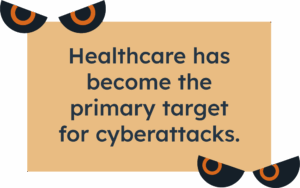Amazon Web Services experienced a major outage last Monday, taking down everything from social media platforms to banking apps and airline reservation systems. For most people, it was an inconvenience. For healthcare organizations, it was much more serious. At least 10 NHS sites were forced to resort to paper records, and many healthcare systems reported delays in operations. Systems went down while patient demand continued. Appointments couldn’t be scheduled, and staff couldn’t access critical tools. Unfortunately, healthcare cybersecurity failures can be felt long after the issue is resolved.
This is what infrastructure failures cost healthcare organizations, and it goes far beyond the technical recovery expenses that make headlines. While last week’s outage wasn’t a cyberattack, it demonstrates the same problem that ransomware and data breaches create: when critical systems go down, the ability to serve patients and generate revenue collapses along with them.
The difference is that cyberattacks are far more common, devastating, and expensive than most healthcare leaders realize. The direct costs get reported, but the hidden profitability damage that persists for months or years rarely does.
The Scale of the Problem
 Healthcare has become the primary target for cyberattacks, and the numbers are telling:
Healthcare has become the primary target for cyberattacks, and the numbers are telling:
- 93% of U.S. healthcare organizations experienced at least one cyberattack in the past year, with the average organization facing 43 separate incidents.
- 72% of healthcare organizations reported that cyberattacks have disrupted patient care in 2025, meaning the majority of health systems are experiencing operational failures that directly affect their ability to treat patients.
- Healthcare data breaches cost an average of $10.22 million in the United States in 2025, up 9% from the previous year and significantly higher than the global healthcare average of $7.42 million.
- This marks the 14th consecutive year that healthcare has been the costliest industry for data breaches.
The Operational Disruption That Destroys Revenue
When ransomware locks down hospital systems or a data breach forces operations offline, the immediate revenue loss is obvious. Emergency rooms divert ambulances, surgeries get postponed, and diagnostic equipment stops functioning. Every hour of downtime represents thousands of dollars in lost revenue as patients who need care can’t receive it.
Additionally, healthcare organizations took an average of 279 days to identify and contain breaches in 2025, which is five weeks longer than the global average across all industries. During that extended window, systems operate in degraded states. Electronic health records may be inaccessible or unreliable, scheduling systems don’t function properly, patient portals fail, and communication between departments breaks down.
The cumulative revenue impact of 279 days of operational disruption is enormous, yet it rarely gets calculated as part of the breach cost. Finance teams track the ransom payment and recovery expenses. They account for the regulatory fines. But they often miss the millions in lost revenue from procedures that didn’t happen, patients who went elsewhere, and operational inefficiencies that persisted for months during and after the incident.
Consider a health system performing 50 surgeries per day at an average net revenue of $15,000 per procedure. If a ransomware attack shuts down surgical operations for just one week, that’s $5.25 million in lost revenue. If recovery efforts cause scheduling disruptions and reduced capacity for the following month, the cumulative revenue loss can easily exceed $20 million. Breach cost calculations rarely count those costs, even though they dwarf the ransom payment itself.
 The Patient Loss That Compounds Over Time
The Patient Loss That Compounds Over Time
Beyond immediate operational disruption, cybersecurity failures inflict lasting damage that changes patient behavior and erodes long-term profitability. This is where the hidden costs become truly severe.
Recent studies found that 54% of organizations that experienced supply chain cyberattacks saw increased mortality rates, while 36% reported delays in procedures and tests that resulted in poor outcomes. When patients or their families experience these kinds of care disruptions, they rarely return.
The economics are brutal. Healthcare organizations invest significant resources in acquiring primary care patients, understanding that the real value comes from downstream specialty referrals over the years. A patient who needs orthopedic surgery but chooses a different health system because they remember when your organization couldn’t access their medical records during a cyberattack represents a complete loss of that acquisition investment, plus the high-margin specialty revenue you were counting on.
Even patients who don’t experience direct care disruptions may leave after learning about a data breach that exposed their personal health information. Trust, once broken, is very difficult to rebuild. Local media coverage of the breach ensures that potential new patients in your market are aware of the incident, creating reputation damage that undermines patient acquisition efforts for months or years.
Nearly half of breached healthcare organizations raise prices to cover breach costs, with nearly one-third raising prices 15% or more. Higher prices create additional patient acquisition challenges as cost-conscious consumers seek alternatives, further compounding the profitability problem.
The Competitive Disadvantage That Persists
Cybersecurity failures don’t affect all organizations equally. Because when your health system suffers a publicized breach, competitors benefit directly.
Patients researching providers after seeing news about your cyberattack will find your competitors’ reputations improved by comparison. The competitive dynamics inevitably shift. Organizations that avoided high-profile incidents maintain stable patient volumes and acquisition costs, while breached organizations suddenly face higher costs and lower conversion rates.
The loss becomes particularly brutal over time. Organizations that invest adequately in cybersecurity protection maintain stable operations and patient relationships. Those that underinvest face recurring breaches, each one creating operational disruption, revenue loss, and reputation damage that leaves them weaker for the next attack, causing the revenue gap to widen with each incident.
Why Traditional ROI Calculations Miss the Point
When healthcare organizations evaluate cybersecurity investments, the analysis typically focuses on avoiding direct breach costs like ransom payments, recovery expenses, and regulatory fines. But those measurable costs represent only a fraction of the true financial impact.
Consider the full cost picture. The average cost of the single most damaging cybersecurity incident in 2025 was $3.9 million. That’s substantial, but add the hidden costs:
- Revenue lost during operational disruptions that can extend for weeks or months.
- Patient lifetime value that evaporates when care disruptions drive patients to competitors.
- Competitive market share loss that persists for years as reputation damage undermines patient acquisition.
- Price increases needed to cover breach costs that make you less competitive.
In other words, the cumulative impact of these hidden costs can easily exceed the direct breach costs by a factor of five or ten. A $500,000 investment in cybersecurity infrastructure that IT couldn’t justify based solely on breach prevention suddenly becomes extremely compelling when the full impact is considered. The ROI calculation completely changes when you account for revenue protection, patient retention, and competitive positioning.
What Actually Needs to Change
 For healthcare organizations serious about sustainability, the solution requires treating cybersecurity as a strategic business priority rather than just an IT function.
For healthcare organizations serious about sustainability, the solution requires treating cybersecurity as a strategic business priority rather than just an IT function.
Leadership needs to understand that cybersecurity failures create profitability problems that extend far beyond ransom payments and recovery costs. When evaluating security investments, the analysis should include revenue protection, patient retention, competitive positioning, and long-term profitability impacts.
Organizations should track operational metrics before and after security incidents to quantify the true cost. When surgeries get postponed due to a ransomware attack, that revenue loss needs to be captured as a breach cost. When patient volumes decline in affected service areas, that lifetime value impact should be measured and attributed to the security failure.
Most importantly, healthcare organizations need to recognize that adequate cybersecurity spending isn’t optional in today’s threat environment. Hospitals typically spend only two to three percent of operating revenue on IT, compared to ten percent at financial institutions. This underinvestment creates vulnerabilities that attackers exploit.
It’s becoming more and more crucial for healthcare companies to recognize cybersecurity as a financial driver rather than a cost center. They’ll make strategic investments in protection that pay for themselves many times over by avoiding the operational disruptions, patient losses, and competitive disadvantages that cybersecurity failures create.
A Different Approach to the Same Problem
The conversation about cybersecurity in healthcare has focused too narrowly on technical prevention and breach response. What’s missing is recognition that cybersecurity failures create strategic business problems that affect the bottom line in ways that persist long after systems are restored.
Healthcare organizations need better frameworks for understanding and communicating these impacts. Cybersecurity investments become easier to prioritize when leadership can see the full financial implications. This includes revenue loss, patient churn, and competitive disadvantage.
Some organizations are finding that proactive approaches to patient engagement can help mitigate the downstream impacts of cybersecurity disruptions. When operational systems go down, organizations with sophisticated patient targeting capabilities can more efficiently re-engage affected patients and minimize long-term patient loss. When credibility damage from a breach undermines patient acquisition efforts, reputation management tools can significantly lessen the impact. Just as importantly, comprehensive ROI tracking systems allow organizations to measure the actual financial impact of security incidents in ways that inform future investment decisions and demonstrate the true value of prevention.
These capabilities don’t prevent breaches, but they can reduce damage by maintaining patient experience efficiency during and after cybersecurity incidents. In an environment where breaches have become nearly inevitable, the ability to limit downstream impact becomes a huge competitive advantage.











